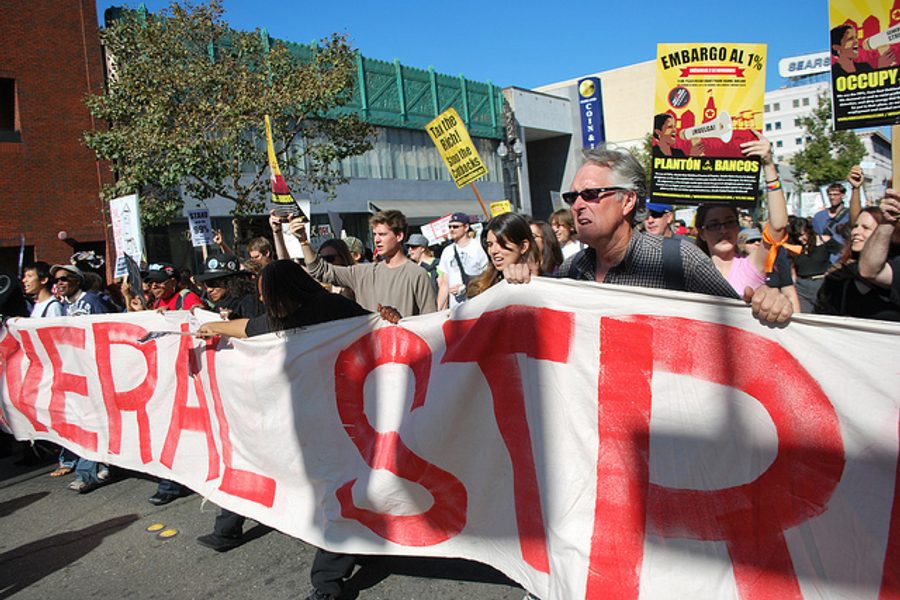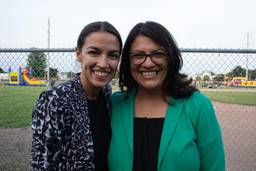
… and what’s the difference between it and a “day of action”? It may seem pedantic, but the terminology has already caused significant debate.
A general strike has traditionally been defined as a work stoppage by a critical mass of labor in a given location. The daily processes of accumulation are stopped and neglected political questions come to the forefront of public debate.
Anti-austerity movements in Europe and elsewhere have recently seen such strikes, with millions in the street, mustering support for threatened social services. In the past, workers have similarly mobilized over a host of issues in the United States. General strikes took place in Saint Louis in 1877, New Orleans in 1892, Seattle in 1919, San Francisco in 1934, and Oakland in 1946. All were visible demonstrations of capital’s dependence on labor.
Occupy will not be able to match the scale of these actions, but many believe keeping the concept in circulation is important in itself. Critiquing the movement’s rhetoric, labor journalist Laura Clawson disagrees:
So it’s a day of action, right? That can encompass all sorts of really effective and exciting organizing and it is no insult to observe that it’s not the same thing as a general strike. But claiming you’re doing something with a specific meaning and not organizing to actually do it, not even reaching out to the people who have experience at the closest thing to what you’re claiming to be planning, does a disservice to the concept of the general strike and to the Occupy movement. And once you start calling any old day of action a ‘general strike,’ you’re conceding that you’ve given up on the idea of a real general strike being possible.
But as Natasha Lennard argues in Salon, Occupy’s expectations aren’t quite so lofty. A strike among the unemployed and precariously employed — the “unorganized” working class — would look different than the general strikes of yesteryear.
But the question of whether a general strike can take place without organized labor’s formal support seems to me moot at this point: No one is working under the impression that May Day in New York will resemble the general strikes of 1946, for example, or even contemporary general strikes elsewhere, like last week in Spain, when two powerful unions called a general strike and 3 million people took to the streets.
Lennard concludes by stating that it “… might be high time that the media stop turning to union leaders to ask about what a general strike could mean.”
Much of this country’s union leadership, historically, has been hostile to the tactic. It was the national leadership of the American Federation of Labor, for example, that opposed Seattle’s 1919 general strike and put pressure on the radicals behind it.
But could today’s union leaders endorse a general strike if they wanted to?
Not technically. As Joe Burns writes in Reviving the Strike: How Working People Can Regain Power and Transform America, a “system of labor control” was slowly erected in the decades following the passage of the National Labor Relations Act. Most famously, in 1947, the Taft-Hartley Act outlawed actions in support of workers at other firms, effectively criminalizing solidarity. Industry-wide strikes, a tactic for generations, were no more.
Even if there were the will among union leadership, that means that something as innocuous as passing around pamphlets in support of others in different workplaces, much less a general strike, would be illegal. There are ways to circumvent these restrictions. Some unionized workers are taking sick days, vowing to participate in slowdowns, or just joining the May Day rallies after work.
But Burns has a far bolder plan. He suggests the erection of independent worker organizations, technically outside of unions, without assets or property, which would be able to blatantly violate Taft-Hartley and other unjust laws.
Of course, for all of labor’s enthusiasm for Occupy and for all the individual activism by union members, only a small minority is calling for such militancy. Occupy’s actions tomorrow, whatever you want to call them, may be a positive influence. Labor and Occupy could complement each other. Labor has numbers, discipline, and organization, while Occupy invokes a rich history of American extra-parliamentary and extra-legal resistance.
Whatever happens tomorrow, it should be a step in the right direction.

I hope you found this article important. Before you leave, I want to ask you to consider supporting our work with a donation. In These Times needs readers like you to help sustain our mission. We don’t depend on—or want—corporate advertising or deep-pocketed billionaires to fund our journalism. We’re supported by you, the reader, so we can focus on covering the issues that matter most to the progressive movement without fear or compromise.
Our work isn’t hidden behind a paywall because of people like you who support our journalism. We want to keep it that way. If you value the work we do and the movements we cover, please consider donating to In These Times.



